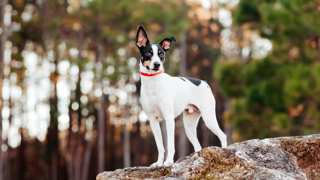Rat Terrier Breed Details
The Rat Terrier, as its name suggests, is a member of the Terrier group of breeds. Dogs of this breed were developed in America in the early twentieth century to hunt vermin; they have a terrier's typical personality of intelligence, spirit, and stubbornness, and are great companions for families of any size.
Some Rat Terrier facts: these dogs exist in two size variations (Miniature and Standard). Miniatures average 11 inches at the shoulders in height, while Standards are about 15 inches in height; weight for both variations averages 17 pounds. All have short-haired, smooth coats that come in a wide variety of colors. Now for some Rat Terrier pros and cons:
PROS:
- Intelligent and eager to please
- Playful and fun-loving
- Fairly low maintenance needs
- Athletic and agile; often considered the best terrier for ratting
- Great with kids and other pets
- Most easily trained of any terrier breed
- Adapts well to apartment living
- Very easy to groom
- Low barking tendency
CONS:
- Excellent escape artists
- Not good in colder climates
- Strong prey drive; will chase and possibly injure smaller pets (especially rodents)
- Prone to excessive digging
- May turn destructive if left alone or bored
- Can be stubborn and strong-willed
- Early/frequent socialization recommended
- Sheds moderately

















